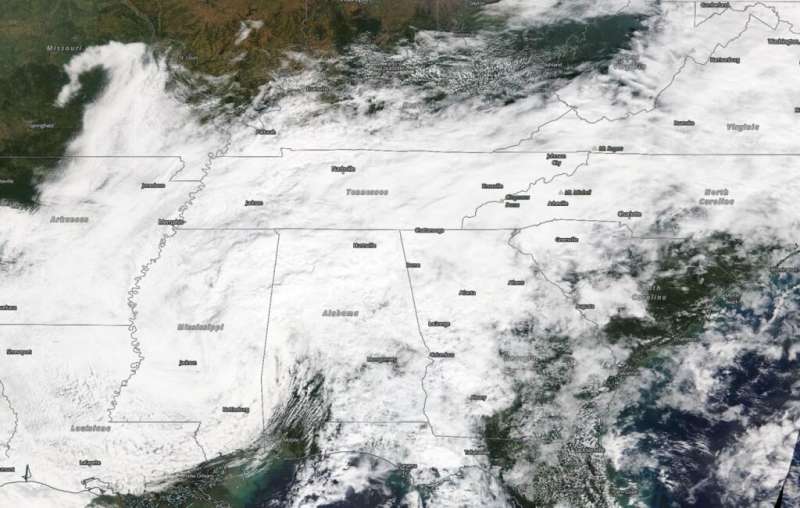NASA finds post-tropical storm Beta's clouds blanketing the Southeastern US

NASA's Terra satellite obtained visible imagery of Post-Tropical Cyclone Beta as it continued moving slowly through the Tennessee Valley. Clouds associated with the low-pressure area looked like a large white blanket draped across much of the southeastern U.S.
On Sept. 25, NOAA's National Weather Service Weather Prediction Center (WPC) in College Park, Md. noted Beta was moving slowly northeast. It was centered about 60 miles (100 km) north-northeast of Birmingham, Alabama.
A NASA Satellite View
The Moderate Resolution Imaging Spectroradiometer or MODIS instrument that flies aboard NASA's Terra satellite captured a visible image of Post Tropical Storm Beta moving slowly through the Tennessee Valley on Sept. 24 and the center of the storm did not move much by Sept. 25. The MODIS image revealed a blanket of clouds associated with Beta stretched from Mississippi to the Carolinas.
The Valley is the drainage basin of the Tennessee River and is largely within the state of Tennessee. It extends from southwestern Kentucky to north Georgia and from northeast Mississippi to the mountains of North Carolina and Virginia.
Satellite imagery was created using NASA's Worldview product at NASA's Goddard Space Flight Center in Greenbelt, Md.
Beta's Status on Sept. 25
On Sept. 25, Beta's center had become less determinant in the pressure and wind fields. In addition, the heavy rainfall threat with Beta has diminished.
At 5 a.m. EDT (0900 UTC) on Sept. 25, NOAA's WPC issued the last public advisory issued on this system. At that time, the center of Post-Tropical Cyclone Beta was located near latitude 34.3 degrees north and longitude 86.3 degrees west. The post-tropical cyclone was moving toward the northeast near 10 mph (17 kph) until it becomes indistinguishable within the background wind and pressure field by mid-afternoon Friday. Maximum sustained winds are near 10 mph (20 kph) with higher gusts.
WPC forecasts rainfall totals of 1 to 3 inches expected through Friday from the southern Appalachians into the Piedmont of South and North Carolina. Isolated flash, urban, and small stream flooding is possible.
About NASA's Worldview and Terra Satellite
NASA's Earth Observing System Data and Information System (EOSDIS) Worldview application provides the capability to interactively browse over 700 global, full-resolution satellite imagery layers and then download the underlying data. Many of the available imagery layers are updated within three hours of observation, essentially showing the entire Earth as it looks "right now."
NASA's Terra satellite is one in a fleet of NASA satellites that provide data for hurricane research.
Hurricanes/tropical cyclones are the most powerful weather events on Earth. NASA's expertise in space and scientific exploration contributes to essential services provided to the American people by other federal agencies, such as hurricane weather forecasting.
More information: For local weather forecasts, visit: www.weather.gov
Provided by NASA's Goddard Space Flight Center




















